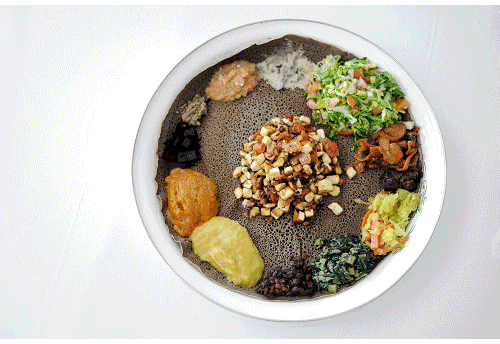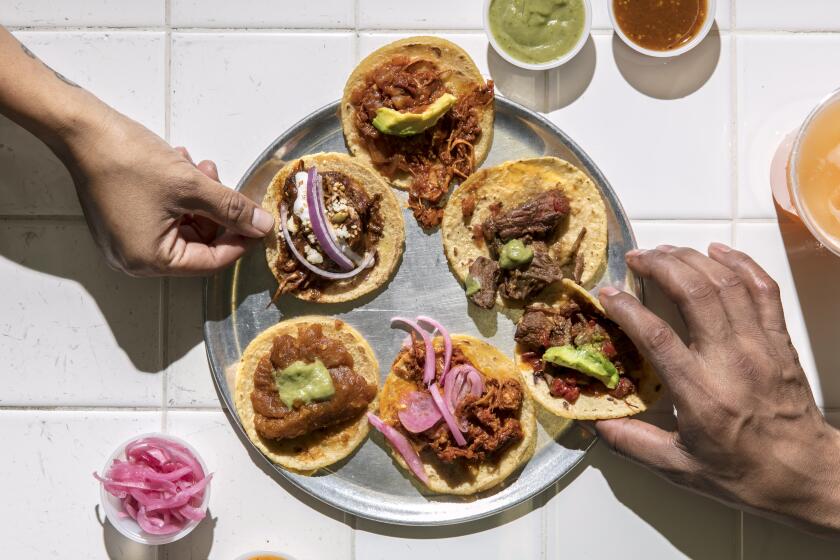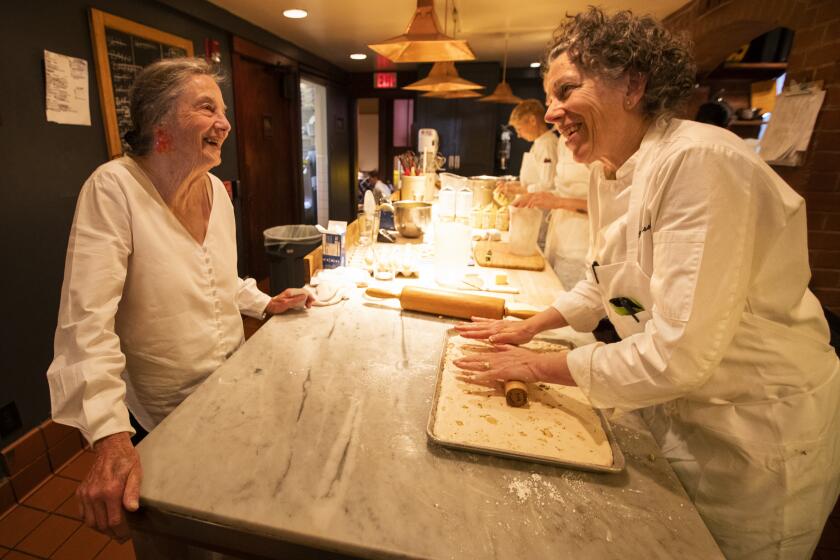L.A.’s 15 best dishes of 2019
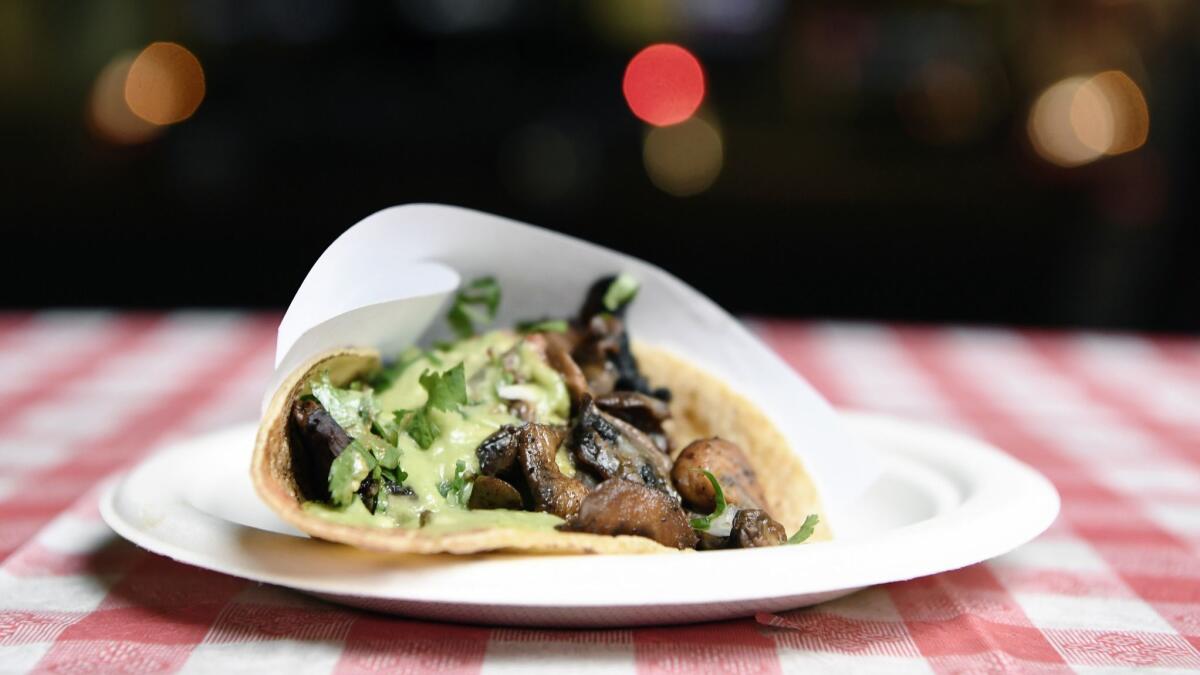
- Share via
[Looking for the 2019 101 Best Restaurants in L.A. list? Look no further.]
As year-end lists go, wrangling something as wondrously complex as the Los Angeles dining scene is always a fraught task. 2019 provided plenty of threads to chase. The resurgence of French cuisine saw its apex in posh restaurants with chefs who operate on poultry like surgeons. Birria mania began to rival taco obsession. Singular specialties originating from Taiwan, Korea, Italy, China, Japan and the Philippines reflected regional influences — and equally the enthralling imaginations of the minds that fashioned them.
For the record:
12:36 p.m. Dec. 27, 2019An earlier version of this article said the foie de poulet à la Strasbourgeoise at Pasjoli costs $39 for two slices. It costs $20 for two slices and $42 for six slices.
The official L.A. Times list of the 101 best restaurants in Los Angeles, curated by our restaurant critics.
Like many of you, at a wild moment in American history we looked to dining to fulfill myriad roles in our lives: solace, community, entertainment, inspiration. When we glanced back over our year’s worth of reviews, these were the dishes that best conveyed not only meals we loved but also summarized the culinary moment in Southern California.
Patricia Escárcega’s picks
Casunziei, Colapasta
At his low-key pasta restaurant near Santa Monica’s Third Street Promenade, chef Stefano De Lorenzo makes one of the most memorable pasta dishes I ate this year: casunziei, the beet-filled ravioli native to northeast Italy, where the chef was born and raised. The floppy half-moon dumplings are golden-yellow around the edges, with a brooding, ruby-colored center where the beet filling stained the dough. Months later, I still daydream about the meld of sweet roasted beets against brown butter, and the way the punctuation-size poppy seeds scattered over the pasta softly crackle under the teeth. I can eat two bowls of casunziei in one sitting. Apologies to my Keto-obsessed friends.
1241 5th St., Santa Monica, (310) 310-8336, colapasta.restaurant
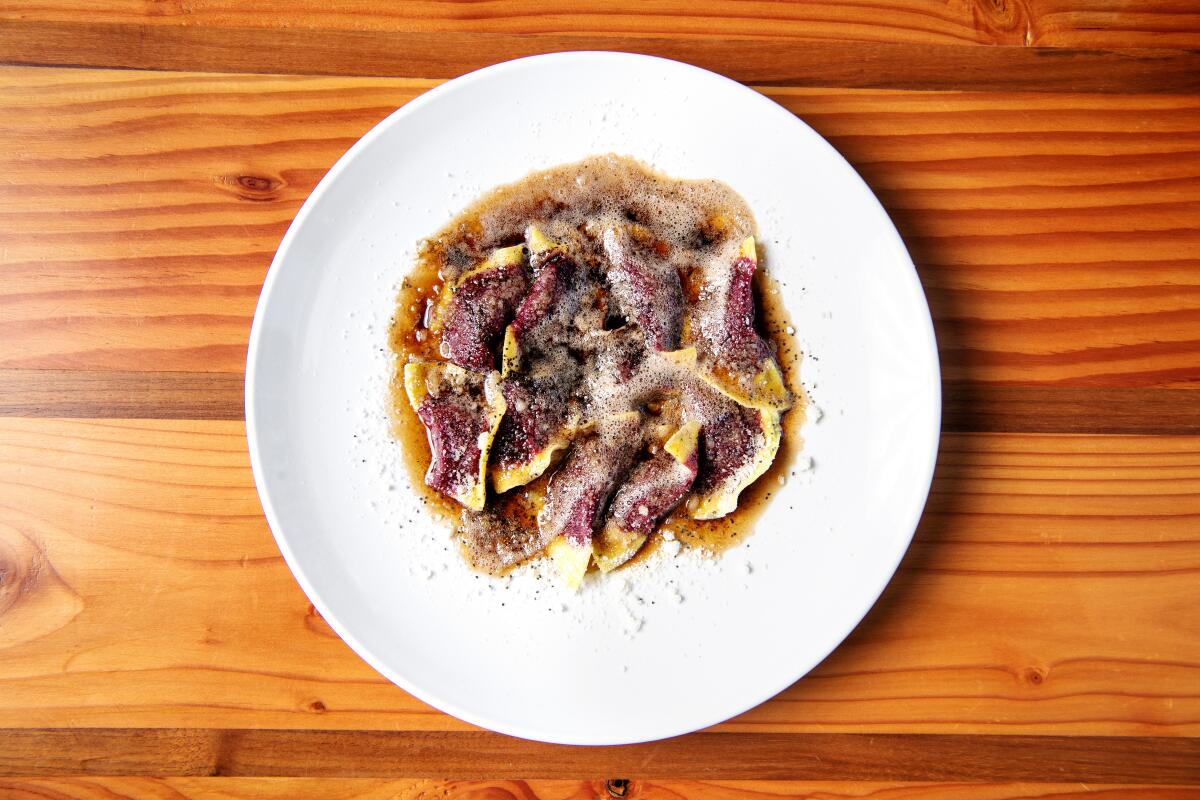
Barbecue, Kra Z Kai’s BBQ
On my regular trips to visit family in the Inland Empire, home to 11 of my aunts and uncles and roughly 200 cousins (give or take a few dozen), I inevitably find myself pit-stopping at Kra Z Kai’s in Corona, one of only a handful of restaurants in Southern California dedicated to Laotian barbecued meats. I leave the restaurant weighed down with Styrofoam containers bursting with what owner Musky Bilavarn calls “Laotian party food”: chicken wings lacquered in a sweet, shiny oyster sauce; sticky pork ribs marinated in soy and garlic paired with snowballs of sticky rice; and beef dip, lightly charred, served with a chile-cilantro lime sauce for dunking. My favorite thing on the menu is the house-made Laotian sausage. The crusty-edged brat-size link is a bracing blend of coarsely ground pork, onions, leeks and lemongrass, the flavors pinging from sour to salty to savory. It makes me look forward to more Laotian eating in 2020.
1218 Magnolia Ave., #110, Corona, (951) 268-6968
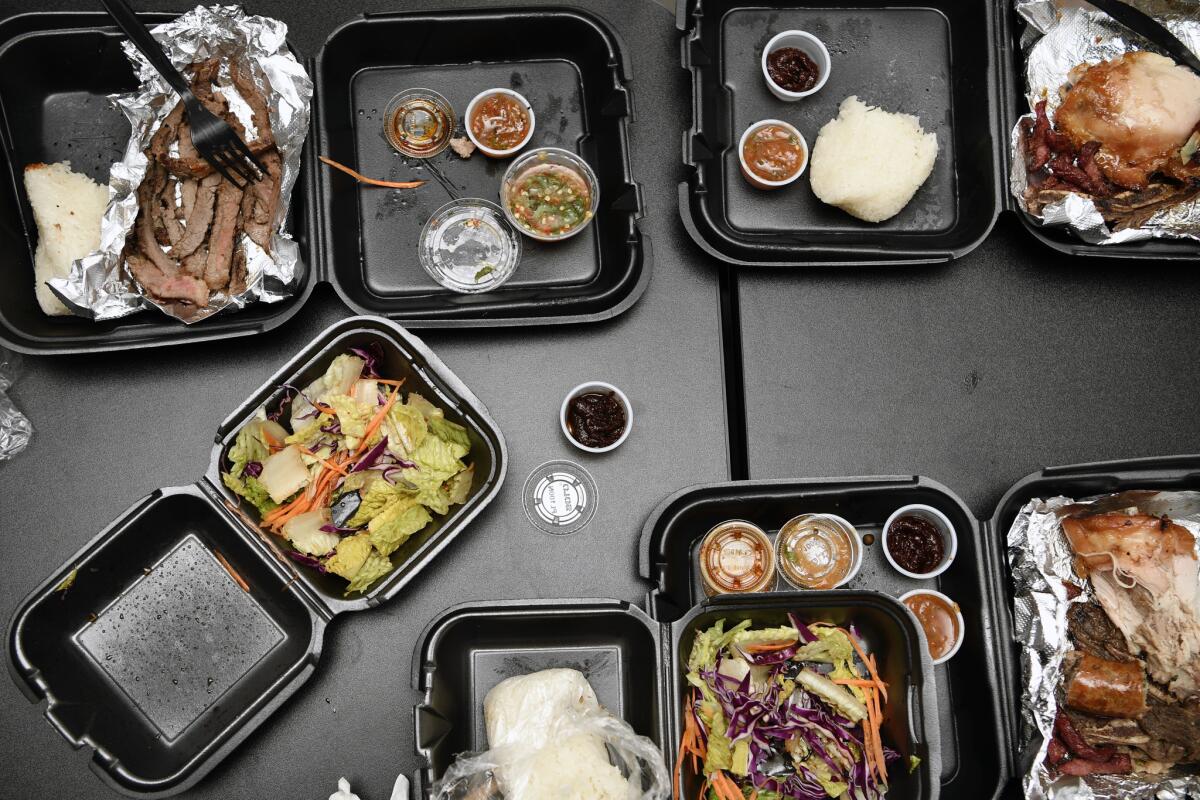
Tres moles enchilada plate, La Diosa de los Moles
Earlier this year, I reviewed La Diosa de los Moles in Paramount, a restaurant from Rocío Camacho, Los Angeles’ self-proclaimed Diosa de los Moles (Mole Goddess). Although Camacho has cooked in top Mexican kitchens for more than three decades, the review generated a fair amount of reader email from mole lovers discovering Camacho’s thoughtful, detailed cooking for the first time. Camacho’s tres enchiladas plate is the perfect vehicle to explore her deep mole repertoire. Order the cheese-filled enchiladas blanketed with any of the seven moles on the menu. I recommend her singular mole Oaxaqueño, a thick, inky sauce underscored by notes of smoke and fruit. Her dark red mole poblano expertly balances the bitterness of chocolate with the sweetness of dried fruits. Camacho’s pastel-green pistachio mole — opulently creamy with flashes of chile heat — is reason enough to stop by for dinner.
8335 Rosecrans Ave., Paramount, (562) 740-8710, paramountmexicanfood.com
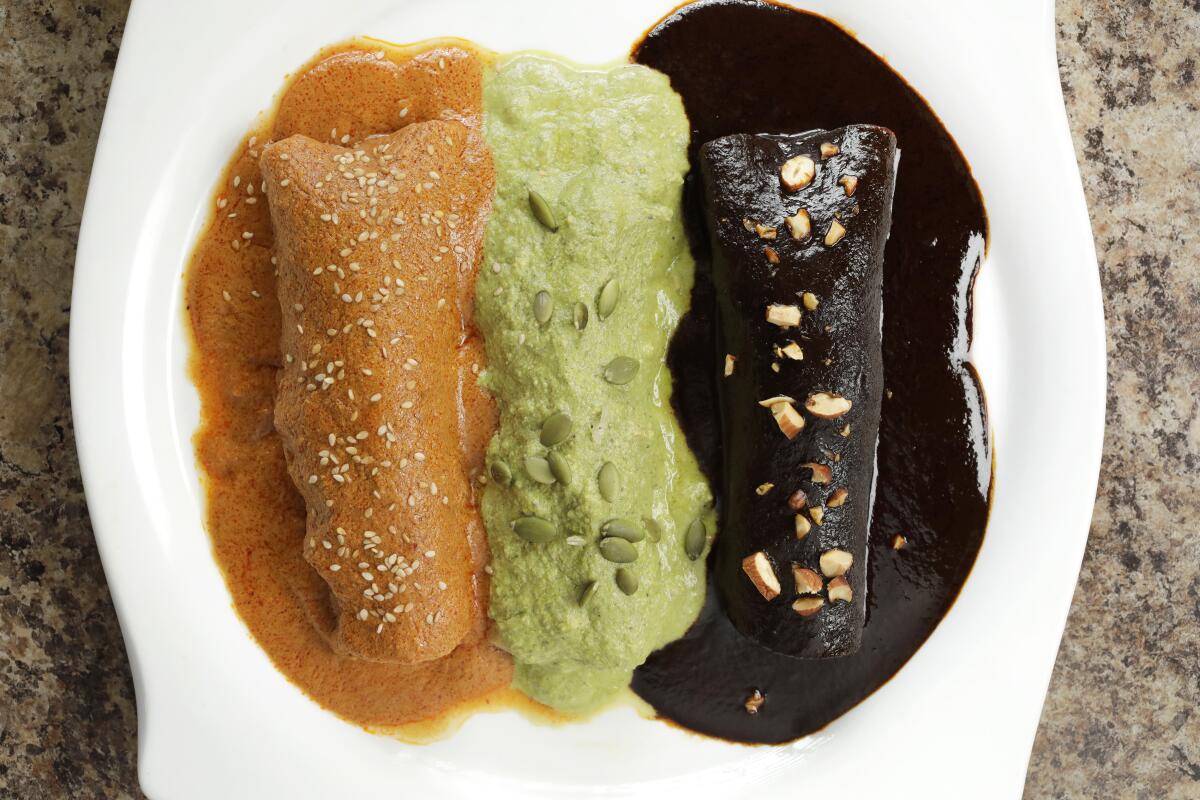
Looking for tacos and more great Mexican food on our 101 Best Restaurants list? It’s right here.
Congee, Nightshade
When it debuted, Mei Lin’s Arts District restaurant produced a highlight reel of instantly recognizable dishes: mapo tofu lasagna, a block of egg noodles piped with tofu cream and layered with a Sichuan pepper-infused pork ragù; Sichuan hot quail served on a thick slice of Japanese milk bread; and a take on the bloomin’ onion served with coconut-lime ranch sauce. I keep returning to the joys of Lin’s congee, which showcases her meticulous, cerebral cooking style but also her gift for reimagining familiar comfort foods. The short-grain rice porridge is accessorized with mounds of pork floss, fried garlic, chopped green onions, crispy wontons, a wobbly egg and a dash of XO sauce. Stirred together, the flavors build and expand. It’s soulful, smart cooking.
923 E. 3rd St., #109, Los Angeles, (213) 626-8888, nightshadela.com
Patita, Spoon & Pork
Spoon & Pork — chefs Ray Yaptinchay and Jay Tugas’ ode to Filipino comfort food in Silver Lake — produced my favorite pork dish of the year: A version of crispy pata (deep-fried pig’s trotter) that involves braising pork shank for 15 hours and then air-drying it for 24 hours before it meets the fryer. The patita’s improbably thin, snappy crust is half the joy of eating it, and the supple meat rolls off the bone. Round out the meaty splendor with one of the kitchen’s formidable vegetable dishes. Eggplant insalata with salted egg cream and snippets of fresh herbs is smoky and surprisingly rich; coco jack, a creamy, gingery version of the jackfruit and coconut dish called ginataang langka, is every shade of sweet and salty.
3131 Sunset Blvd., Los Angeles, (323) 922-6061, spoonandpork.com
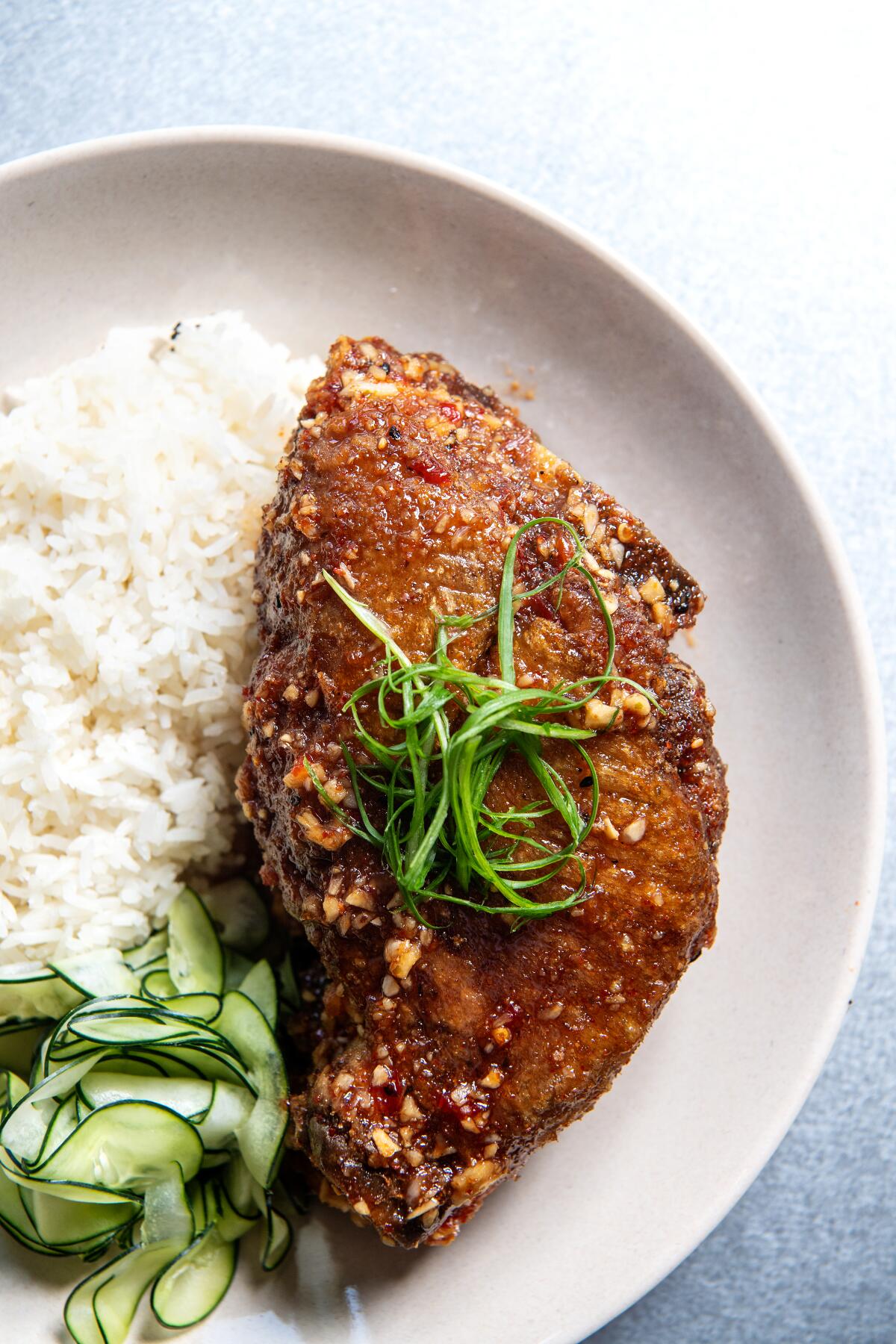
Birria, Tacos y Birria La Unica
When I look back on 2019, I will remember it fondly as the year I drank flagons of birria, the flagrantly meaty broth rendered from beef or goat. I will remember the chile-blistered glory of the Tijuana-style birria de res Deluxe plate at Teddy’s Red Tacos. I cannot forget the clamor of standing in line at Birrieria Gomez, where the thunderous LAX-bound commercial jets rattle the windows of all the trucks on La Cienega Boulevard. (It’s the closest birria truck to the L.A. Times office.) My fondest birria memory of the year is standing in line at Tacos y Birria La Unica in Boyle Heights, the wildly popular, hand-polished lonchera dedicated to Michoacán-style birria de chivo. It was an especially cool morning when I visited, the wind whipping the trees around on Olympic Boulevard. Somebody handed me a tall Styrofoam cup of birria de chivo. The warm, garlicky, goaty consomé, concentrated with full-force meaty intensity, was the closest thing to warming my hand by a fire.
2840 E. Olympic Blvd., Los Angeles, (323) 715-4025, facebook.com/TacosyBirriaLaUnica/
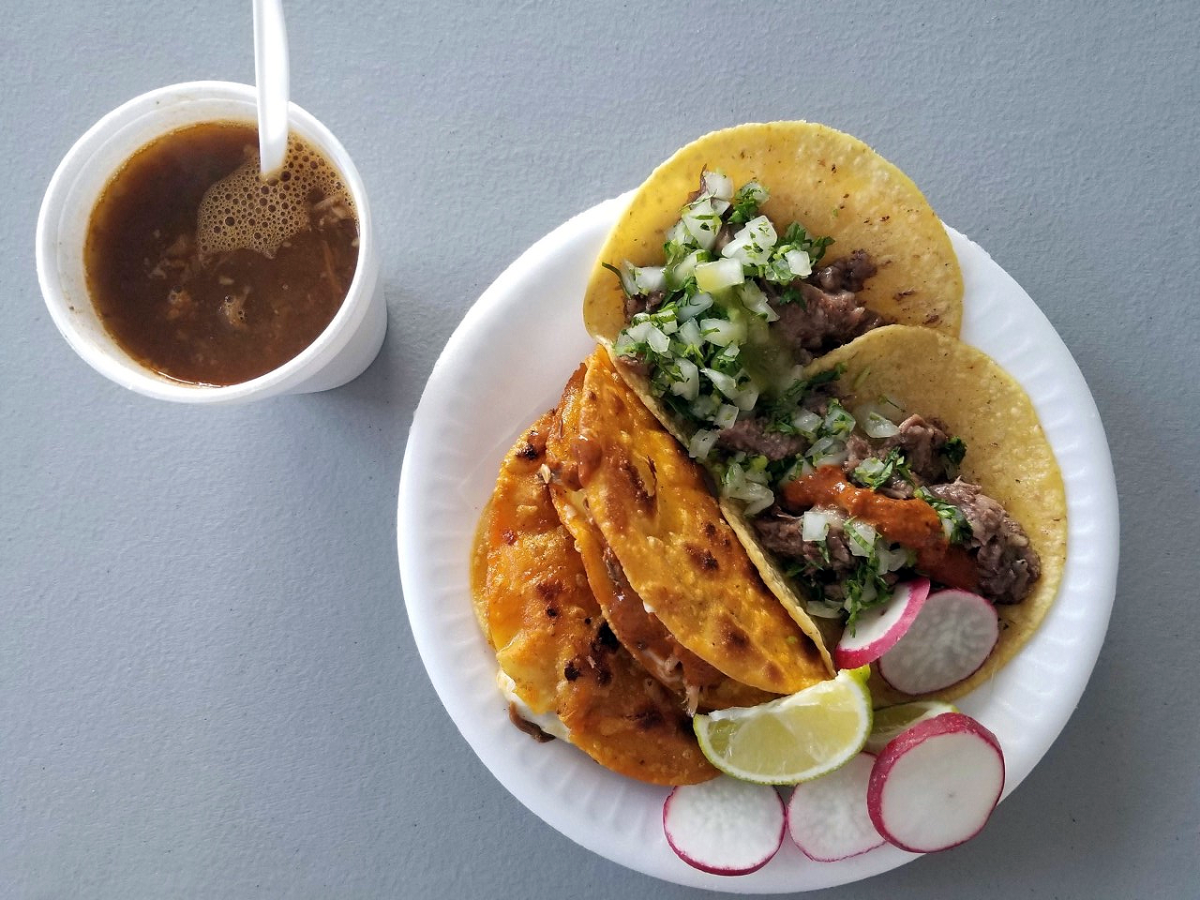
In 2019, Los Angeles’ bowls runneth over with birria, the Mexican confederation of recipes involving meat rubbed, roasted or slowly stewed in an alloy of chilies, herbs and spices.
Gelato, Bulgarini Gelateria
The most eccentric tasting menu I ate this year was chef Leo Bulgarini’s pasta-wine-gelato dinner at Bulgarini Gelato Artigianale, his small gelateria and restaurant in Altadena. The evening included pappardelle paired with a dark red Zinfandel and a sublime peach gelato and potato gnocchi followed by pistachio gelato dribbled with a little Bordeaux. But as good as the pasta and wine are, it’s Bulgarini’s obsessively crafted gelati — the brooding Florentine chocolate gelato with sea salt, the utterly smooth and creamy Sicilian pistachio gelato, any of the seasonal fruit varieties, whose intense flavors channel time and place — that keep me going back.
749 E. Altadena Drive, Altadena, (626) 791-6174, bulgarinigelato.com
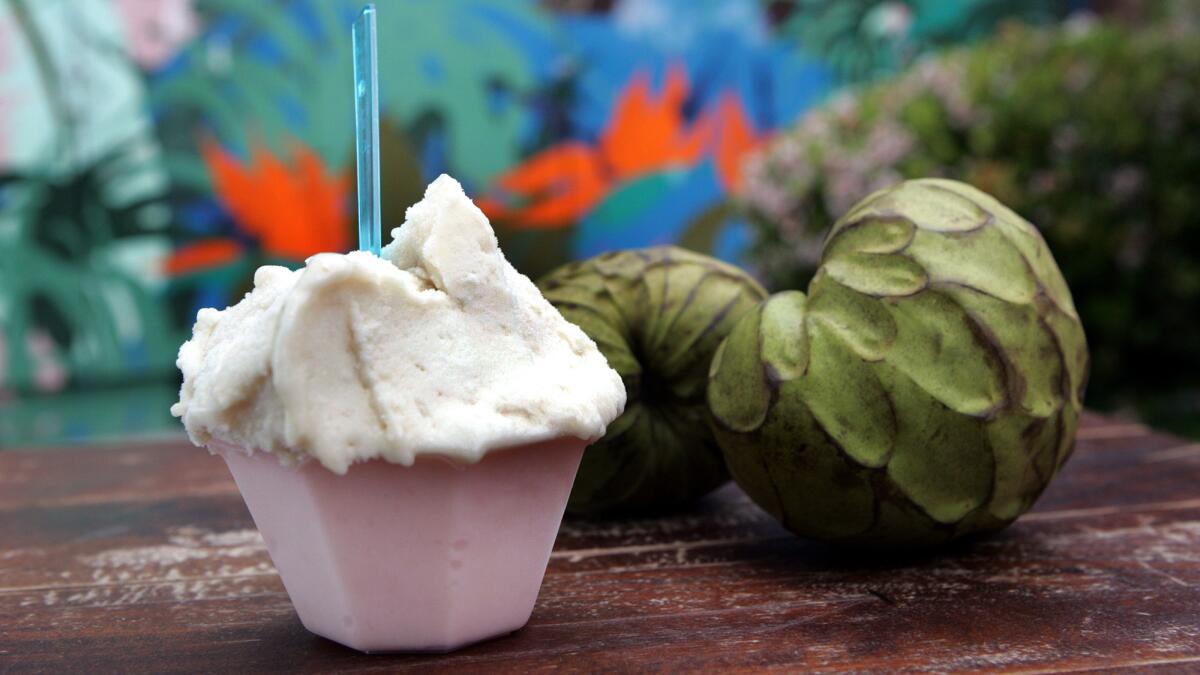
Bill Addison’s picks
Taco al hongo, Tacos 1986
Those of us who laid eyes on Jorge “Joy” Alvarez-Tostado earlier this year knew he was a rock-god taquero in the making: He stood in front of a slowly spinning trompo at his Koreatown street stand, preening and puckering his lips for smartphone cameras while whipping up mic-drop tacos. He and Tacos 1986 co-owner Victor Delgado landed a permanent location downtown in June. Though the obvious taco filling would be adobada shaved from the trompo, the sly upstart is the hongos — mushrooms sautéed in salsa macha and then griddled to crackling meatiness. Ask for them on a taco or on a vampiro, an open-faced corn tortilla cooked on the plancha until crisp-soft and undulating (and resembling bat’s wings — one possible explanation for the dish’s nickname). Dressed con todo, either comes with cilantro, onion and, in the style of Tijuana taquerias, a slick of guacamole. Sensational.
609 S. Spring St., (213) 988-7202, tacos1986.com

Within months of opening, Tacos 1986 ascended to the ranks of L.A.’s most popular taco spots.
Beef noodle soup, Yang’s Kitchen
I have my standbys for Taiwanese beef noodle soup: Temple City’s Dai Ho, Lao Tao in Chinatown and Silver Lake’s Pine and Crane. The version Chris Yang makes at his fast-casual Alhambra restaurant is a new favorite. He starts by emphasizing California ingredients: The meat for his soup comes from Santa Carota, a ranch near Bakersfield known for its carrot-fed cattle; Pasadena’s Grist & Toll mills the red-wheat flour for the broad noodles. He dials back the spice in his broth to underscore pure beefiness, the result of simmering neck, knuckle and shank bones for 36 hours. Fermented mustard greens are a classic garnish, but there’s also fresh, frilly chrysanthemum greens for an herbal hit. Stir in the house-made chile crisp (which the restaurant should sell in jars) and you have liftoff. Yang’s short menu of scallion pancakes, wraps, noodles and salads is personal in conception and universal in appeal, but the soup is his illuminating statement of intent.
112 W. Main St., Alhambra, (626) 281-1035, yangskitchenla.com

In this episode of “Off Menu,” Lucas Kwan Peterson heads to the Chinese food mecca the San Gabriel Valley, and chats with historian David Chan and Kato’s Jon Yao.
Foie de poulet à la Strasbourgeoise, Pasjoli
At his second Santa Monica restaurant, Dave Beran trains his brainpower on reengineered French classics that straddle bistro and haute-dining traditions: scallop quenelle in caviar beurre blanc, onion tart, trout amandine, chocolate souffle, rice pudding in a cloud of cream. The canard à la presse, presented tableside and served in courses, is getting its due accolades. I applaud all of these transmigrations, but I’m most obsessed with Pasjoli’s chicken liver. It’s Beran’s counteroffensive on the California foie gras ban: He fattens chicken livers with butter, spikes them with Madeira, rolls them in the method of foie gras au torchon, stuffs the livery cylinder in brioche and showers the whole thing with black truffles before it leaves the kitchen. Two slices, with a side of truffled shallot marmalade, cost $20. It is absurdist debauchery. It is a brainiac’s art project. It is worth the splurge, even as a stop-in snack at the bar accompanied by an Armagnac cocktail.
2732 Main St., Santa Monica, (424) 330-0020, pasjoli.com
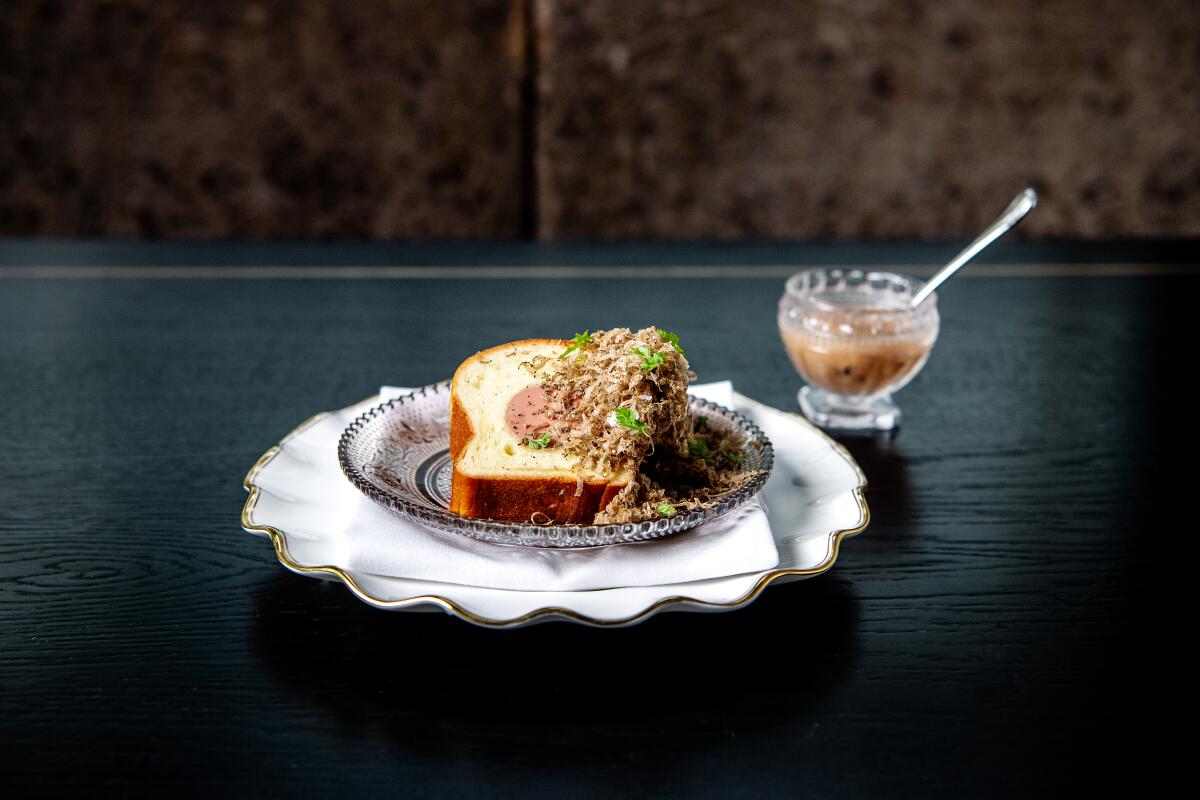
Pork belly and dumpling soup, Spoon by H
When I ask myself what I want to eat for an off-critic-duty lunch, Yoonjin Hwang’s take on mandu guk most often comes to mind. Hers is made with a cloudy, porky liquid that evokes tonkotsu ramen. She crimps dumplings filled with pork, vegetables and tofu in rippling pleats, stirs in glass noodles along with the traditional rice cakes and finishes the soup with carrots, zucchini, red chile flakes and battered onion bits. Savored spoonful by nuanced spoonful at Hwang’s sunlit Beverly Boulevard cafe (which largely specializes in photogenic desserts), the soup is a lullaby — and also a triumphant anthem of individualism.
7158 Beverly Blvd., Los Angeles, (323) 930-0789, spoonbyh.com
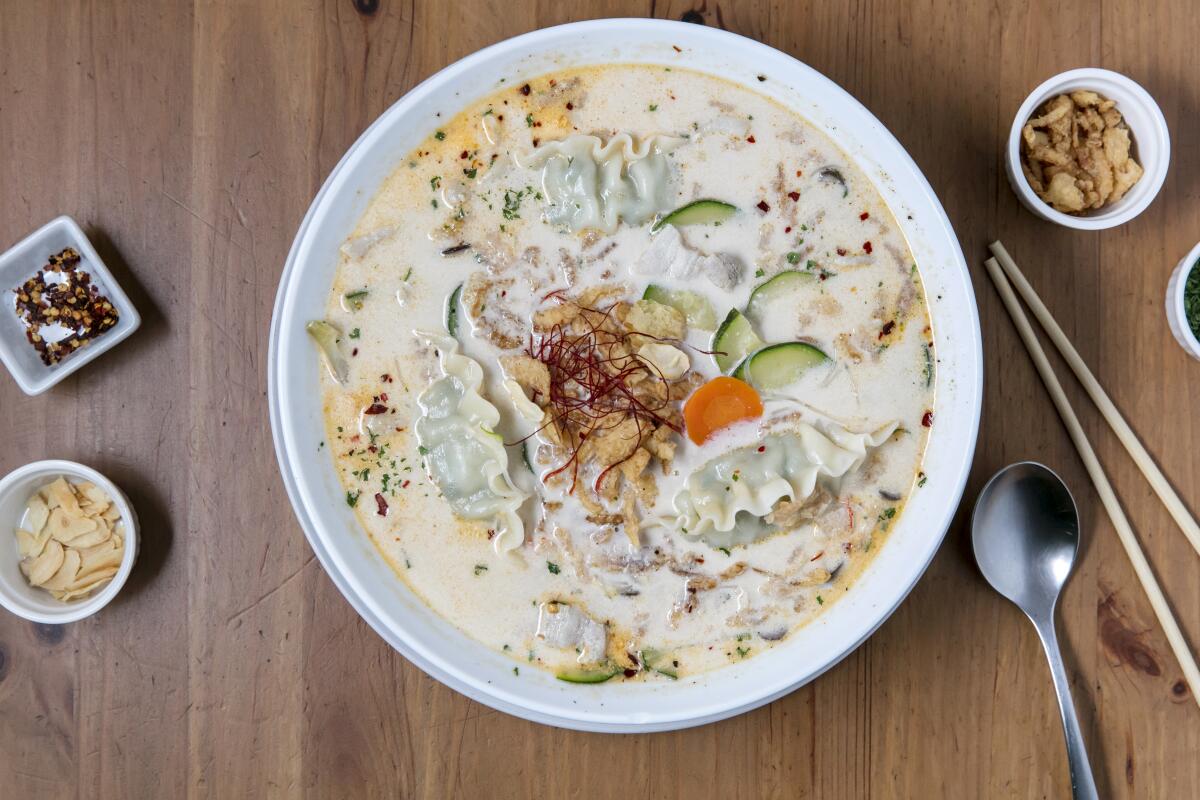
Summertime tea salad, Porridge + Puffs
Minh Phan won me over early this year with the signature dishes that comprise her restaurant’s name. When I returned in August, there was a salad, new to the menu, based on the spent oolong leaves Phan used to make iced tea. She cured the leaves in tepache, a beverage made from fermented pineapples or other fruits, until they were fruity-funky and a little fizzy (in the most pleasing possible way). For the salad she piles the leaves with salad greens into a bowl and covers them in a free verse of fruits and vegetables: jasmine-pickled apricots, slivers of fresh nectarines, ume-pickled daikon, cucumbers fermented in nuka (Japanese rice bran), chile-tinged jicama, roasted carrots, peanuts. It rang through my head for months, a hit song of the summer. The salad has since become a mainstay. Phan tells me her current version includes pine needle-pickled celery root and radishes preserved in yuzu-scented sake leaves — very on brand and very 2019.
2801 Beverly Blvd., Los Angeles, (213) 908-5313, porridgeandpuffs.com
Chicken prepared two ways, Bon Temps
As someone who made desserts in restaurants in a different lifetime, I have a particular admiration for pastry chefs who leap to the savory side of the kitchen with success. After almost 30 years as a pastry chef, Lincoln Carson debuted his first solo restaurant in the spring, serving spectacular morning pastries (hello, strawberry ricotta Danish) and an ambitious French-modern-American dinner menu full of sense-of-occasion dishes. Made-to-share entrees are common stock in pricier restaurants these days, but Carson’s chicken is a revelation. Check it out: Thigh and leg meat is turned into forcemeat, mixed with truffle paste and wrapped in skin from the legs; after slow sous-vide cooking, the skin is fried crisp. The breast meat, massaged with truffle butter, takes its turn in the sous-vide machine and then is also fried. Creamed, truffled leeks hide underneath the meat; baby turnips roll around the platter. I melted over Carson’s desserts (St. Honoré cake, chocolate-chartreuse soufflé, a summertime peach Pavlova), but the chicken’s monster technique and high-gloss beauty had already revealed his true soul as a chef.
712 S. Santa Fe Ave., Los Angeles, (213) 784-0044, bontempsla.com
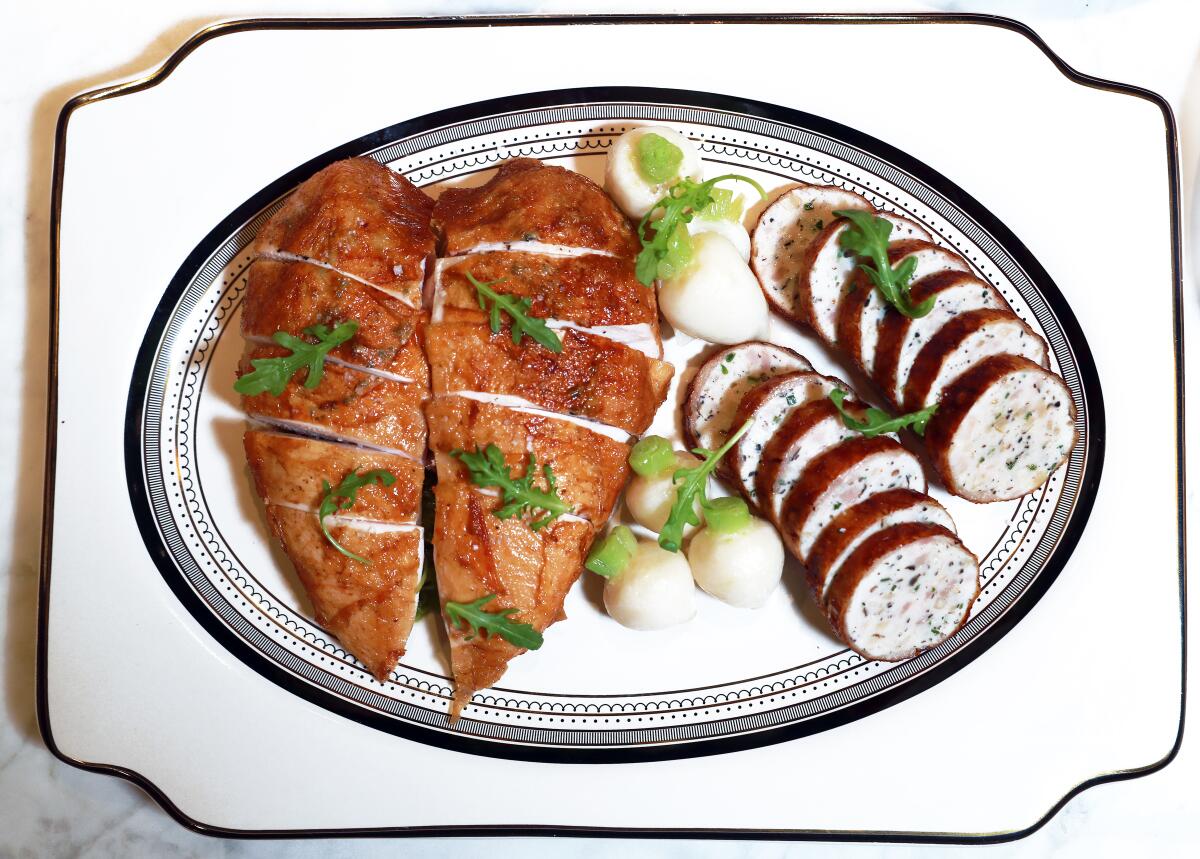
Maze gohan, Hayato
After sushi, sashimi, dashi, hot pot, tempura and other seasonal rhapsodies, the final savory course at Brandon Hayato Go’s seven-seat restaurant is always maze gohan, or “mixed rice.” Go grills an oilier variety of fish, such as king mackerel, before mixing its deboned flesh with the rice in a copper pot. Smoky fat glosses every grain. He serves the maze gohan on a tray with pickles, miso soup and charcoal-roasted hojicha tea, and you can — and will — opt in for seconds — and maybe thirds.
My dinners at Hayato were some of my most extraordinary meals in recent years; I find myself thinking about the rice course more than any other, partly due to its frank deliciousness but also because of the communal moment its presentation engenders. Formality breaks down among the small group of diners; we no longer politely contain our exhilaration. Go has stood in front of us all night cooking; now he starts to quietly philosophize. “Rice is by far the most important food in Japan, and it may be the most important thing in Japan,” he says. “Every aspect of Japanese life for a thousand years has revolved around rice: politics, wealth, war.” We all listen, nodding and rapt.
1320 E. 7th St., Suite 126, Los Angeles, (213) 395-0607, hayatorestaurant.com
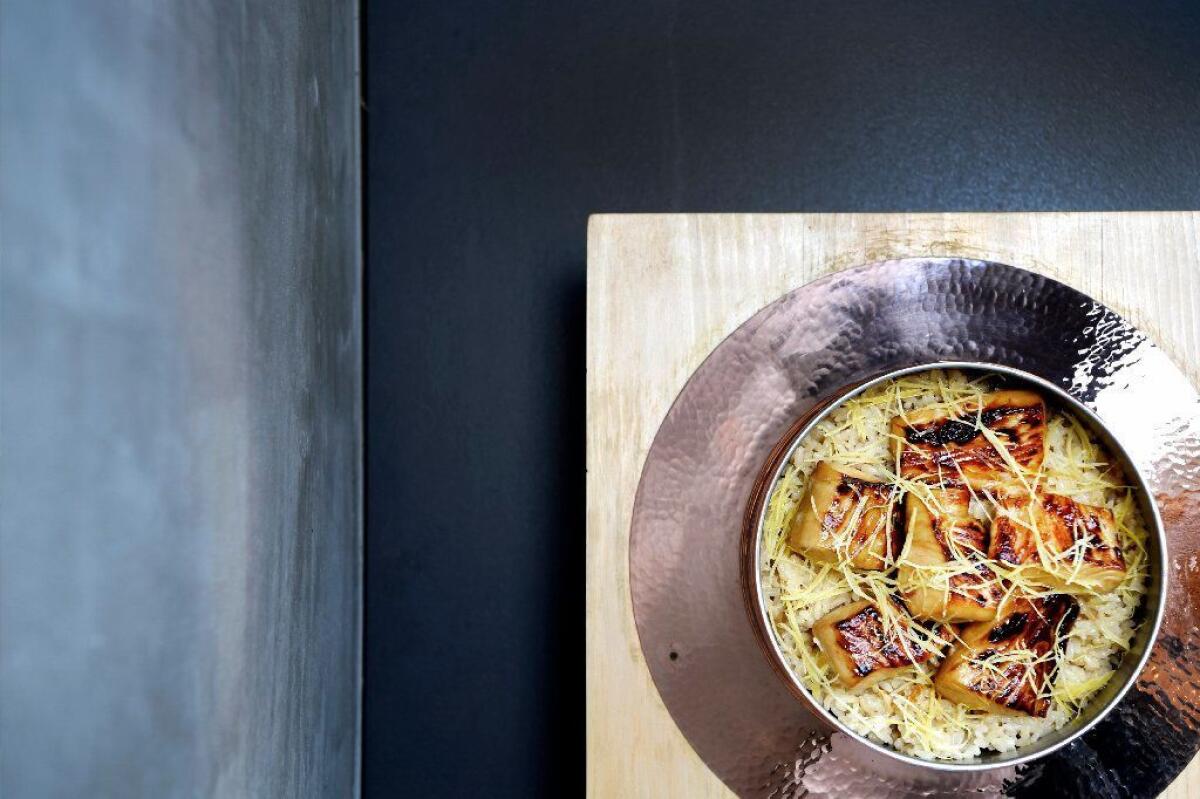
Lime pie, Fiona
Fiona, a bakery and cafe by pastry virtuoso Nicole Rucker, was the first restaurant I reviewed for The Times back in January. I was blown away by her ingenuity with lime pie. She salted the graham cracker crust with enough vigor that its flavor had real presence; she used the extra-tart juice of Mexican limes to slash through sweetened condensed milk; she added sour cream to the billow of whipped cream she dolloped on top. Later I learned that her masterpiece had been born from practicality; limes were fruits she could afford while her new restaurant struggled financially. Fiona closed in August. Was it the location on a nebulous stretch along Fairfax? Or the odd-couple duo of Rucker’s desserts with chef Shawn Pham’s eclectic (and, to my taste, enjoyable) menu? Probably both, among other factors. As a pastry fanatic, I’m sorry Fiona didn’t have its chance to flourish — but Rucker has a new project in the works, and she did include her brilliant lime pie recipe in her recently published cookbook, “Dappled: Baking Recipes for Fruit Lovers.”
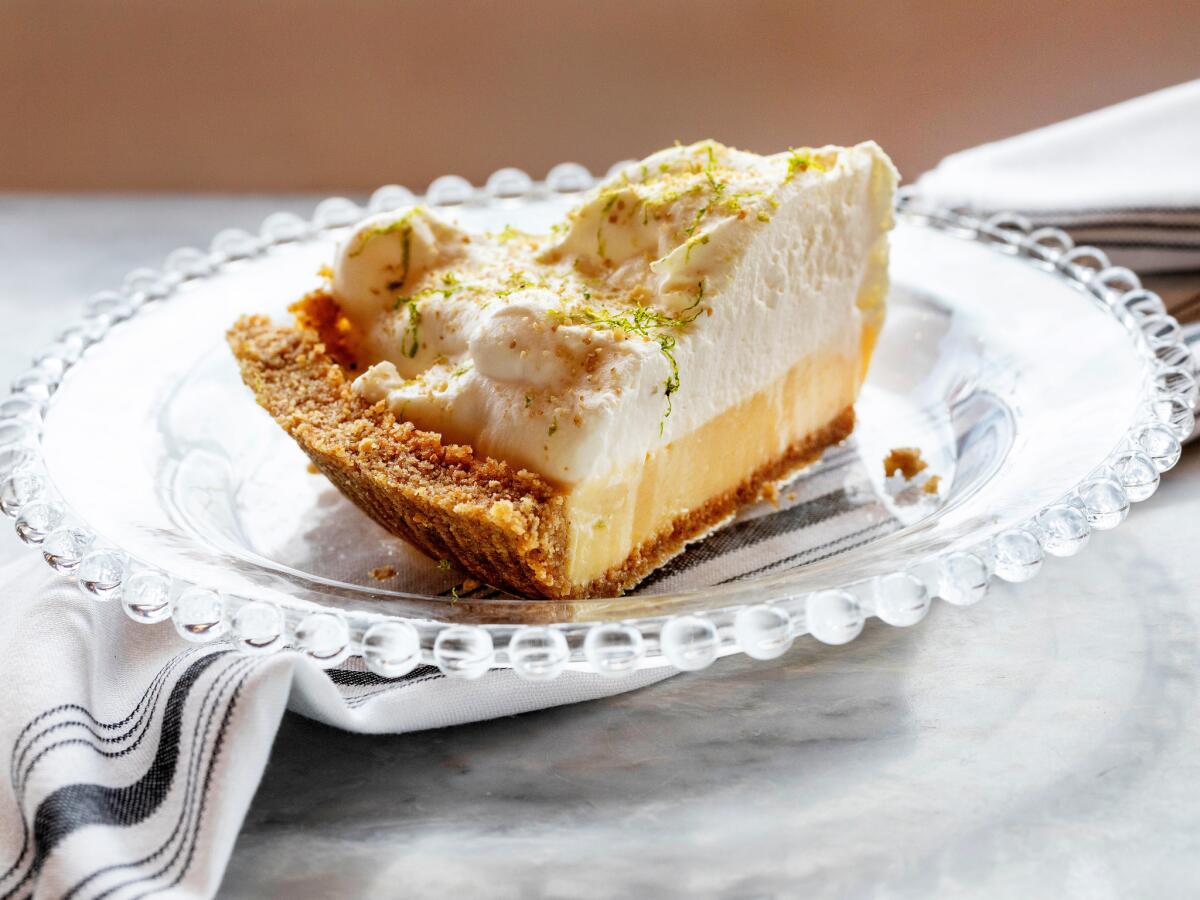
Women are transforming baking’s status in the culinary world and California is at the center of that shift.
More to Read
Eat your way across L.A.
Get our weekly Tasting Notes newsletter for reviews, news and more.
You may occasionally receive promotional content from the Los Angeles Times.
